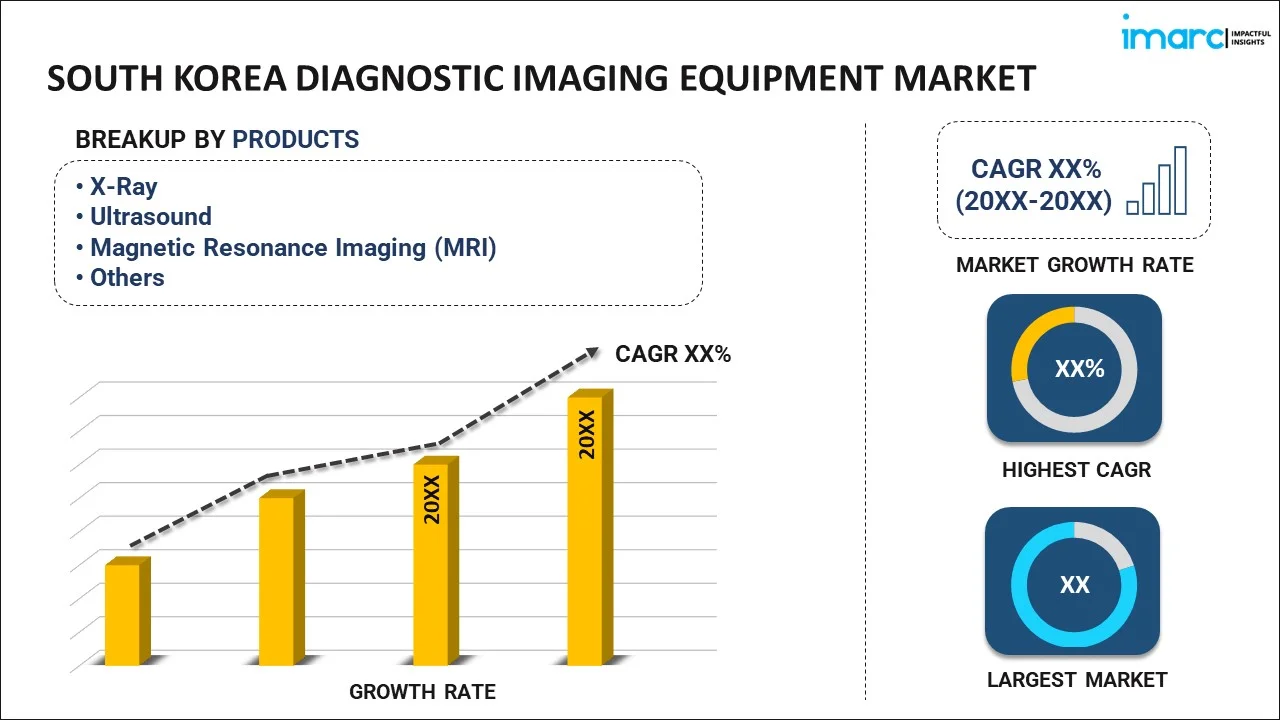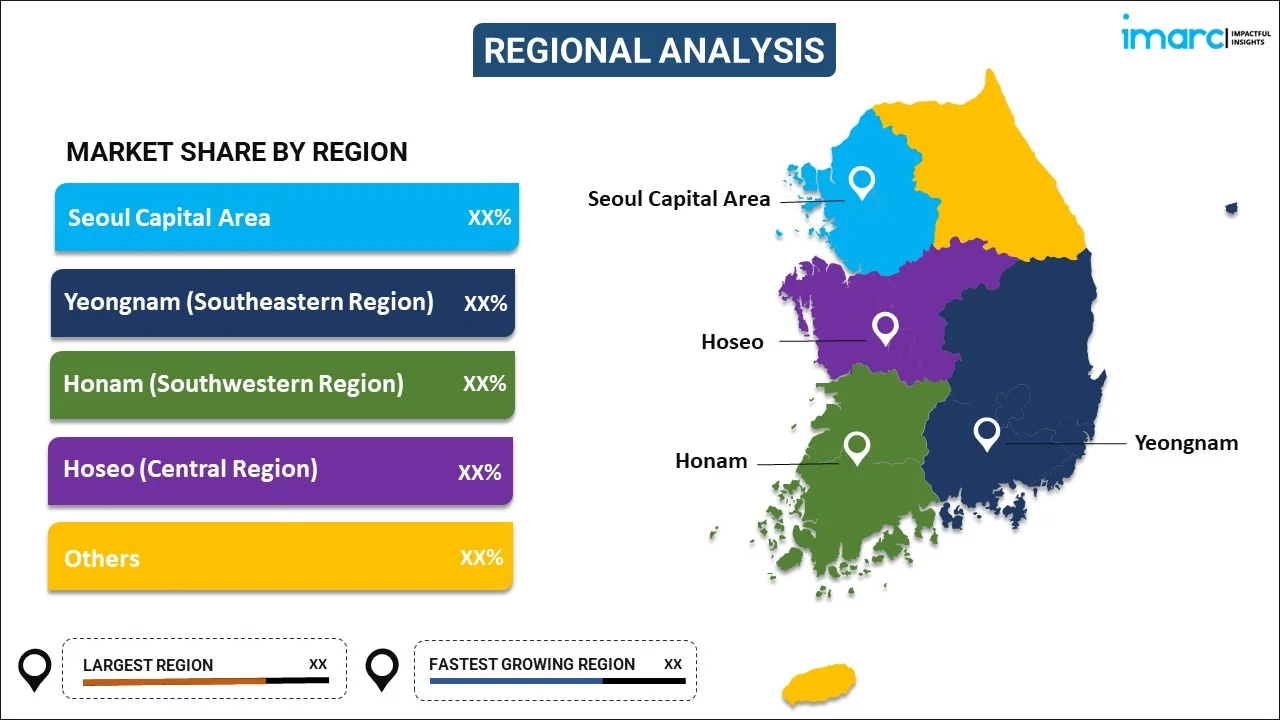
South Korea Diagnostic Imaging Equipment Market Report by Product (X-Ray, Ultrasound, Magnetic Resonance Imaging (MRI), Computed Tomography, Nuclear Medicine, Fluoroscope, Mammography), Application (Cardiology, Oncology, Neurology, Orthopedic, Gastroenterology, Gynecology, and Others), End User (Hospitals, Diagnostic Centers, and Others), and Region 2025-2033
Market Overview:
South Korea diagnostic imaging equipment market size reached USD 480.0 Million in 2024. Looking forward, IMARC Group expects the market to reach USD 830.0 Million by 2033, exhibiting a growth rate (CAGR) of 5.6% during 2025-2033. The increasing prevalence of chronic diseases, widespread availability of advanced diagnostic equipment, and the expansion of hospitals, clinics, and other healthcare facilities in the country represent some of the key factors driving the market.
|
Report Attribute
|
Key Statistics
|
|---|---|
|
Base Year
|
2024
|
|
Forecast Years
|
2025-2033
|
|
Historical Years
|
2019-2024
|
|
Market Size in 2024
|
USD 480.0 Million |
|
Market Forecast in 2033
|
USD 830.0 Million |
| Market Growth Rate 2025-2033 | 5.6% |
Diagnostic imaging equipment enables healthcare professionals to obtain detailed visualizations of the internal structures of the human body. It encompasses a wide range of technologies, including X-ray machines, computed tomography (CT) scanners, magnetic resonance imaging (MRI) machines, ultrasound systems, and nuclear medicine equipment. It works by emitting a controlled amount of radiation through the body, capturing the resulting images on a specialized detector. It aids in the accurate diagnosis and monitoring of various medical conditions. It offers high-resolution images, enabling detailed visualization of anatomical structures and abnormalities. It is widely used for diagnosing conditions like cancer and assessing organ function by tracking the distribution of radioactive substances. Besides this, it is also utilized for fetal monitoring during pregnancy and assessing abdominal and vascular conditions. Moreover, it is employed for visualizing soft tissues, including the brain, spinal cord, and muscles, and diagnosing neurological and musculoskeletal disorders.
South Korea Diagnostic Imaging Equipment Market Trends:
The increasing aging population, which is highly susceptible to cardiovascular diseases, cancer, and neurological disorders, represents one of the key factors strengthening the growth of the market in South Korea. Apart from this, the robust healthcare infrastructure in the country is offering a favorable market outlook. South Korea has a well-developed and accessible healthcare system that places a strong emphasis on early diagnosis and treatment. Along with this, the widespread availability of advanced diagnostic equipment across the country is facilitating patient care and driving the demand for the latest imaging technologies. Moreover, leading manufacturers are continually investing in research and development (R&D) activities to introduce cutting-edge technologies, such as advanced MRI machines with higher resolution and faster scanning capabilities. Furthermore, the growing awareness about the benefits of early disease detection and personalized medicine is catalyzing the demand for more precise and sophisticated diagnostic imaging tools. The integration of artificial intelligence (AI) and machine learning into diagnostic imaging equipment is also supporting the market growth in the country. AI algorithms can assist radiologists in interpreting images more accurately and quickly, leading to more efficient diagnoses. Besides this, governing authorities of the country are promoting routine health check-ups for its citizens, which often include various imaging procedures to detect potential health issues at an early stage. In addition, the widespread adoption of telehealth services, including remote diagnosis and monitoring, which relies heavily on diagnostic imaging, is propelling the market growth. Furthermore, a continuous rise in medical tourism is bolstering the market growth in the country.
South Korea Diagnostic Imaging Equipment Market Segmentation:
IMARC Group provides an analysis of the key trends in each segment of the market, along with forecasts at the country level for 2025-2033. Our report has categorized the market based on product, application, and end user.
Product Insights:

- X-Ray
- Ultrasound
- Magnetic Resonance Imaging (MRI)
- Computed Tomography
- Nuclear Medicine
- Fluoroscope
- Mammography
The report has provided a detailed breakup and analysis of the market based on the product. This includes X-ray, ultrasound, magnetic resonance imaging (MRI), computed tomography, nuclear medicine, fluoroscope, and mammography.
Application Insights:
- Cardiology
- Oncology
- Neurology
- Orthopedic
- Gastroenterology
- Gynecology
- Others
A detailed breakup and analysis of the market based on the application have also been provided in the report. This includes cardiology, oncology, neurology, orthopedic, gastroenterology, gynecology, and others.
End User Insights:
- Hospitals
- Diagnostic Centers
- Others
The report has provided a detailed breakup and analysis of the market based on the end user. This includes hospitals, diagnostic centers, and others.
Regional Insights:

- Seoul Capital Area
- Yeongnam (Southeastern Region)
- Honam (Southwestern Region)
- Hoseo (Central Region)
- Others
The report has also provided a comprehensive analysis of all the major regional markets, which include Seoul Capital Area, Yeongnam (Southeastern Region), Honam (Southwestern Region), Hoseo (Central Region), and Others.
Competitive Landscape:
The market research report has also provided a comprehensive analysis of the competitive landscape in the market. Competitive analysis such as market structure, key player positioning, top winning strategies, competitive dashboard, and company evaluation quadrant has been covered in the report. Also, detailed profiles of all major companies have been provided.
South Korea Diagnostic Imaging Equipment Market Report Coverage:
| Report Features | Details |
|---|---|
| Base Year of the Analysis | 2024 |
| Historical Period | 2019-2024 |
| Forecast Period | 2025-2033 |
| Units | Million USD |
| Scope of the Report | Exploration of Historical and Forecast Trends, Industry Catalysts and Challenges, Segment-Wise Historical and Predictive Market Assessment:
|
| Products Covered | X-Ray, Ultrasound, Magnetic Resonance Imaging (MRI), Computed Tomography, Nuclear Medicine, Fluoroscope, Mammography |
| Applications Covered | Cardiology, Oncology, Neurology, Orthopedic, Gastroenterology, Gynecology, Others |
| End Users Covered | Hospitals, Diagnostic Centers, Others |
| Regions Covered | Seoul Capital Area, Yeongnam (Southeastern Region), Honam (Southwestern Region), Hoseo (Central Region), Others |
| Customization Scope | 10% Free Customization |
| Post-Sale Analyst Support | 10-12 Weeks |
| Delivery Format | PDF and Excel through Email (We can also provide the editable version of the report in PPT/Word format on special request) |
Key Questions Answered in This Report:
- How has the South Korea diagnostic imaging equipment market performed so far and how will it perform in the coming years?
- What has been the impact of COVID-19 on the South Korea diagnostic imaging equipment market?
- What is the breakup of the South Korea diagnostic imaging equipment market on the basis of product?
- What is the breakup of the South Korea diagnostic imaging equipment market on the basis of application?
- What is the breakup of the South Korea diagnostic imaging equipment market on the basis of end user?
- What are the various stages in the value chain of the South Korea diagnostic imaging equipment market?
- What are the key driving factors and challenges in the South Korea diagnostic imaging equipment?
- What is the structure of the South Korea diagnostic imaging equipment market and who are the key players?
- What is the degree of competition in the South Korea diagnostic imaging equipment market?
Key Benefits for Stakeholders:
- IMARC’s industry report offers a comprehensive quantitative analysis of various market segments, historical and current market trends, market forecasts, and dynamics of the South Korea diagnostic imaging equipment market from 2019-2033.
- The research report provides the latest information on the market drivers, challenges, and opportunities in the South Korea diagnostic imaging equipment market.
- Porter's five forces analysis assist stakeholders in assessing the impact of new entrants, competitive rivalry, supplier power, buyer power, and the threat of substitution. It helps stakeholders to analyze the level of competition within the South Korea diagnostic imaging equipment industry and its attractiveness.
- Competitive landscape allows stakeholders to understand their competitive environment and provides an insight into the current positions of key players in the market.
Need more help?
- Speak to our experienced analysts for insights on the current market scenarios.
- Include additional segments and countries to customize the report as per your requirement.
- Gain an unparalleled competitive advantage in your domain by understanding how to utilize the report and positively impacting your operations and revenue.
- For further assistance, please connect with our analysts.
 Inquire Before Buying
Inquire Before Buying
 Speak to an Analyst
Speak to an Analyst
 Request Brochure
Request Brochure
 Request Customization
Request Customization




.webp)




.webp)












